- Clinical Technology
- Adult Immunization
- Hepatology
- Pediatric Immunization
- Screening
- Psychiatry
- Allergy
- Women's Health
- Cardiology
- Pediatrics
- Dermatology
- Endocrinology
- Pain Management
- Gastroenterology
- Infectious Disease
- Obesity Medicine
- Rheumatology
- Nephrology
- Neurology
- Pulmonology
Skin Signs and Symptoms of Summer Sun: A Photo Essay
Polymorphic light eruption, phototoxicity, solar purpura, basal cell carcinoma, squamous cell carcinoma, keratoacanthoma, venous lakes, photosensitivity-a look at the many adverse effects of too much sun exposure.
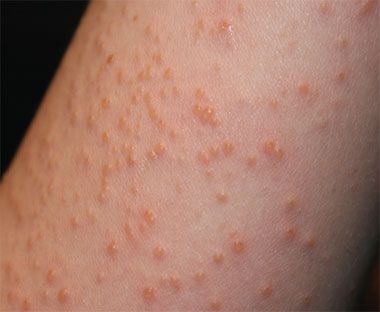
Case 1:
A 13-year-old girl who lived in Canada went on a winter vacation in Hawaii. After a day at the beach, she was awakened on the second day by this intensely itchy, blistering reaction on her forearms and upper chest. The rash persisted for a week despite sun avoidance. No other parts of her body were involved, even though other areas had been exposed to the sun.
She had polymorphic light eruption (PMLE), the most common abnormal reaction to UV light, which classically presents as a papular or papulovesicular eruption on the arms and anterior chest with sparing of the face. A morphological hallmark is the severe involvement of some parts of the body with paradoxical sparing of other similarly exposed areas.
The reaction of PMLE usually begins 12 to 24 hours after an initial exposure to light of a suddenly increased intensity. The rash persists for 7 to 10 days and resolves without scarring but may recur with subsequent intense UV light exposure.
The girl may not experience PMLE during the summer months at home in Canada because the UV light in the northern latitudes may not be intense enough to provoke the reaction. If the rash develops in the spring, it likely will become less prominent and develop less frequently with repeated light exposure over the course of the summer.
NEXT CASE »
For the discussion, click here.
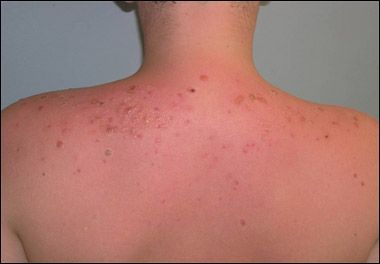
Case 2:
Certain medications may cause dose-dependent non–immune-mediated cell damage in the skin with exposure to sunlight. The cutaneous findings in phototoxic reactions, like the phototoxic drug eruption on this boy’s shoulders, are similar to an exaggerated sunburn-type reaction, with erythema but no edema at sun-exposed sites. Patients often complain of burning and pruritus. Doxycycline is a common cause of phototoxicity in children.
Phototoxicity should be differentiated from photoallergic reactions. Phototoxic reactions occur within hours of sun exposure in any patient exposed to sufficiently high doses of the drug and UV light. They can be avoided by minimizing sun exposure. Photoallergic reactions, presumed to be a type IV hypersensitivity reaction to systemic or topical exposure to an agent, require a period of sensitization: the cutaneous eruption occurs up to 2 weeks after exposure to UV radiation and can reoccur on re-exposure to the medication. To prevent a photoallergic reaction in a patient who is allergic to a particular agent, sun exposure must be avoided completely in the setting of ingestion of the allergen.
The key aspects of managing phototoxicity are discontinuation of the offending agent and avoidance of sun exposure.
Case and image provided by Elizabeth Juhas, MD and Robin P. Gehris, MD
NEXT CASE »
For the discussion, click here.

Case 3:
Solar purpura results from sun-induced damage to the connective tissue of the dermis. It is common in older adults, particularly older white men and women.
Solar purpura manifests as patches and macules that usually are purple and irregularly shaped and range in size from 3 mm to 5 cm. The lesions often occur on a background of dermatoheliosis, which manifests as lichenification, stellate white pseudoscars, and sallow skin color. The purpuric lesions usually are found on the extensor surfaces of the forearms and the dorsa of the hands at sites of minor trauma; they do not extend onto the fingers. Solar purpura also may occur on the neck.
The lesions typically resolve over 1 to 3 weeks. Solar purpura on this older woman’s forearm appears in various stages of resolution. As the patches and macules resolve, they fade to lighter shades of purple, rather than the brown color characteristic of other ecchymoses.
NEXT CASE »
For the discussion, click here.
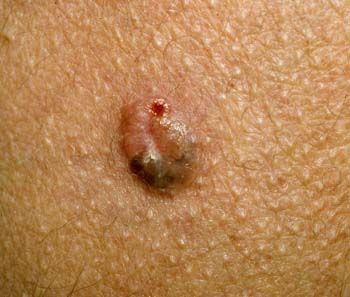
Case 4:
A 47-year-old Hispanic man had been employed as a construction worker for several decades and denied the use of sunscreen. He noted the recent onset of an asymptomatic lesion on his upper arm. The smooth and translucent nature of this nodule suggested the correct diagnosis, basal cell carcinoma.
There was some heavy pigmentation to the lesion that might, justifiably, suggest a diagnosis of melanoma. The lesion was excised with a 5 mm margin of normal skin. Histologic analysis of the specimen confirmed clear peripheral and deep margins.
Basal cell carcinoma can be variably pigmented, especially when the patient’s skin tone is dark. When there is doubt about the diagnosis, a small biopsy is in order to make sure the proper excisional margins are being observed.
Case and photo courtesy of Ted Rosen, MD
NEXT CASE »
For the discussion, click here.
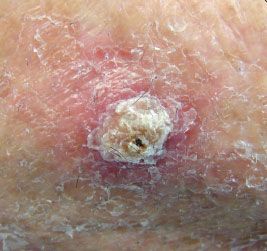
Case 5:
An 82-year-old woman had a history of multiple nonmelanoma skin cancers most likely related to extensive sun exposure throughout life. This asymptomatic lesion developed insidiously on her foreleg. The 2.2- x 1.5-cm nodule was rock-hard with a thick, scaly crust. Inguinal lymph nodes were not enlarged. A biopsy showed invasive squamous cell carcinoma without obvious perineural involvement.
The woman was referred for excision with staged microscopic control (Mohs surgery). The lesion was removed after 3 sequential step excisions, and the defect closed primarily.
The patient remained under close observation for possible recurrence and for skin cancer in general.
Case and image courtesy of Ted Rosen, MD
NEXT CASE »
For the discussion, click here.

Case 6:
These slightly tender nodules erupted on the arms and legs of a 75-year-old woman who had extensive sun damage. A skin biopsy revealed the lesions to be the keratoacanthoma type of squamous cell carcinoma.
A keratoacanthoma often undergoes spontaneous involution. However, eruptive keratoacanthomas of Grzybowski is a generalized distribution of multiple keratoacanthomas that typically do not involute.
The primary treatment for patients with keratoacanthoma is surgery. Medical therapy is reserved for patients with comorbidities that preclude surgery and for those who have multiple lesions or lesions that are not amenable to surgical intervention because of size or location.
NEXT CASE »
For the discussion, click here.
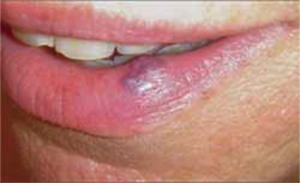
Case 7:
Venous lakes occur on sun-exposed areas, particularly the lips and ears as seen here. They represent dilated venules.
Venous lakes appear as dark blue to purple distensible 0.5- to 2-cm papules. The surrounding skin usually exhibits actinic damage. Venous lakes usually are asymptomatic, but if they are traumatized, there may be pain, tenderness, and excessive bleeding.
Venous lakes often contain thrombi. The likely cause is chronic solar damage to the skin’s vasculature and ground substance that results in dilatation of superficial venous structures with associated thrombosis.
The diagnosis of venous lakes usually can be made clinically. Diascopy performed by placing a glass microscope slide against a venous lake and applying direct pressure causes the lesion to blanch, sometimes incompletely, as its contents are emptied. Mimics-such as cherry angiomas, basal cell carcinoma, and nodular melanoma-do not change color with diascopy.
A shave biopsy can be performed for definitive diagnosis and removal.
NEXT CASE »
For the discussion, click here.
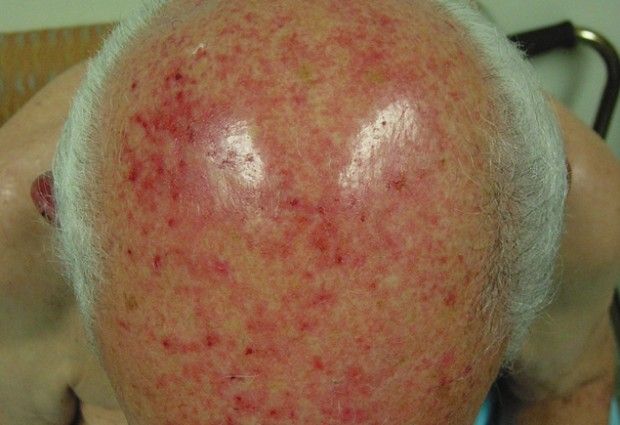
Case 8:
This patient has epidermal growth factor receptor inhibitor photosensitivity. Increased sensitivity to ultraviolet radiation, manifested as sunburn, may occur when patients are receiving EGFR inhibitors. Applying broad-spectrum sunscreens (containing zinc oxide or titanium dioxide) with a sun protection factor higher than 30 is critical.
Dermatologic adverse events caused by cancer therapies have gained considerable attention because of their high frequency, appearance in functional and cosmetically sensitive areas, and association with symptoms of pain and pruritus.
Therapies that target specific pathways or proteins in cancer cells are especially noted for dermatologic events, which affect up to 90% of treated patients.
Case and photo courtesy of Mario E. Lacouture, MD
Atopic Dermatitis: The Pipeline and Clinical Approaches That Could Transform the Standard of Care
September 24th 2025Patient Care tapped the rich trove of research and expert perspectives from the Revolutionizing Atopic Dermatitis 2025 conference to create a snapshot of the AD care of the future.
